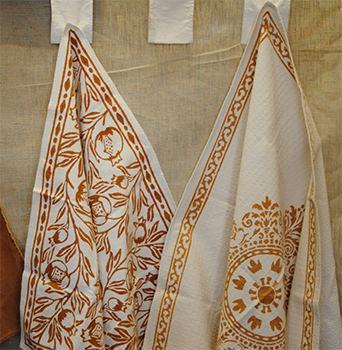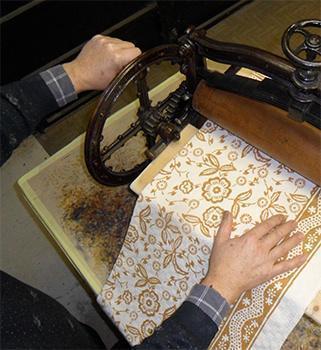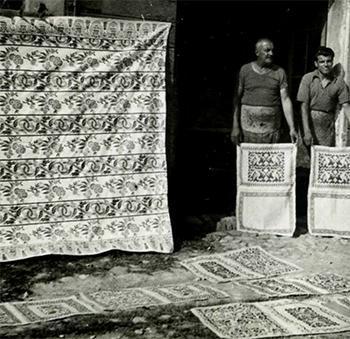Tele di Romagna
Post from EditorialsThe traditional canvas from Romagna (tablecloths, table covers, bedspreads and towels) are the ideal furnishings to give elegance to our homes.
What are the canvas from Romagna
In Romagna it is easy to see the great beauty of home textiles (mainly tablecloths with napkins, table covers, towels, tea towels and bed linen) decorated with traditional designs and made with fine craftsmanship hand printed passed on from the past.
However, the first descriptions of these canvas date back to the early decades of the 800, although it is known that this processing technique was known and practiced in the Papal States (which the Romagna region was part of) in the seventeenth century. It is also logical to think that this type of decoration, which involves the use of manual stamps to make serial decorations, has been developed to imitate - by economic means and easily available (the cultivation of hemp until the last century was in fact extremely common in the country sides of Romagna, in many rural houses was practiced the weaving, and finally the main pigment was extracted from the very common rust) - the very richest and finest embroidered fabrics or woven decorations, such as brocades or lampassi.
Traditional designs of the canvas from Romagna
 The repertoire of traditional designs is extremely varied and includes:
The repertoire of traditional designs is extremely varied and includes:
- Motifs of peasant origin, including for example the representation of plants (vines, grapes, pine cones, sheaf of wheat), animals (roosters, chickens, bulls, doves) and artifacts (including for example vases, jugs and caveje, ie the pivots connecting the wagon and yoke for the oxes).
- Devotional motifs, including scenes from the life of Christ, images of saints and depictions of the Madonna.
- Royal animals (eagles, deers, pheasants, dolphins, panthers, weasels, salamanders, and in more recent times also fishes) or imaginary, which may include dragons, sphinxes and griffins.
- Geometric and floral motifs borrowed from traditional decorations for cloth, generally symmetrical and modular: in this category we find then an amazing variety of depictions of flowers, leaves, branches, twists, spirals and Greek frets which, repeated by varying orientation and grade, allow you to obtain an unlimited range of borders and backgrounds.
In addition, since each laboratory and/ or family of printers had (has) its molds, there are almost endless variations (in the composition, in graphics and style) of each drawing.
Processing of the canvas from Romagna
 The technique for the production of the canvas from Romagna, handed down from generation to generation by the experts printers, involves several work stages.
The technique for the production of the canvas from Romagna, handed down from generation to generation by the experts printers, involves several work stages.
First, the raw canvas, which - for greater fidelity to the well-established tradition - should be of hemp fiber, linen or cotton and woven with a manual loom is fully extended on the work table (slightly padded to allow a better adhesion of the stamp to the fabric), in order to avoid burrs and imperfections during the actual printing.
Subsequently, we move to the drafting of the colors on a special pad, which will serve to inking the woodblock which will be embossed with the design: ancient, the most common color was brown, made from a mixture of rust with a process that every craftsman had its own particular variant of, held strictly confidential. More recently, spreaded other popular colors such as green, red and blue, made from pigments of mineral origin. The wooden mold - usually carved directly by each printer (every shop has indeed its heritage of stamps) in pear wood, considered particularly suitable for the purpose and readily available - are layed on the cloth, beaten with a wooden mallet and then removed and repositioned to repeat the operation.
The wooden mold - usually carved directly by each printer (every shop has indeed its heritage of stamps) in pear wood, considered particularly suitable for the purpose and readily available - are layed on the cloth, beaten with a wooden mallet and then removed and repositioned to repeat the operation.
Once completed the desired design, the fabric is then put out to dry, dipped in a bath of fixative to stabilize the color, and then subjected to vigorous rinses, so as to test its ability to withstand numerous washes with modern detergents (or formerly with lye).
Features an authentic canvas from Romagna
Compared with paintings made industrially, it is possible to recognize a genuine canvas from Romagna (made with the traditional technique of molding by hand) from the following elements:
- Drawing visible on the reverse side of the cloth, although it is less visible compared to the front side; furthermore, right at the back of the fabric are more perceivable the inevitable imperfections of a hand-printed fabric.
- Slight imperfections in the design, such as small smudges or areas of color that are not perfectly homogeneous (lighter or darker): these small manufacturing defects are inevitable even in the work performed by the most skilled craftsman and highly valued because they make unique and unrepeatable any printed canvas; they are due either to inaccuracies in the engraving or to the wear of the wooden mold the design is printed with, or to the imperfect application of color on the mold or to the different strength of a mallet.
- Small asymmetries in the serial motifs: in fact, as the serial motifs, such as the borders of bedspreads and tablecloths or symmetrical decorations, are made by printing several times the same mold, generally you notice slight defects in the rendering, includingsmall jumps share in the alignment of the drawing, or variable intervals in the repetition of the basic pattern and/ or small rotations of the same.
Artisan producers of the canvas from Romagna
 To date, as with industrial methods you can get printed fabrics so much faster and cheaper (even if the final product is obviously of much lower quality and far less valuable), craft shops specializing in the production of authentic canvas from Romagna are unfortunately very few.
To date, as with industrial methods you can get printed fabrics so much faster and cheaper (even if the final product is obviously of much lower quality and far less valuable), craft shops specializing in the production of authentic canvas from Romagna are unfortunately very few.
However, in 1997 these producers have decided to group up in a network by founding the Association of Printmakers Canvas from Romagna, whose members represent one of the many excellences of the Made in Italy.
So, if you want to buy an authentic canvas from Romagna to beautify your home, you can contact the best retailers of linens (the canvas from Romagna are in fact exported to other regions as well) or go directly to one of the shops recommended in the site of the Association.
79777 REGISTERED USERS










